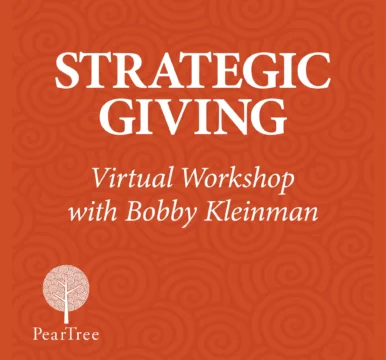This Forum contains the sole opinions & insights of the author based on forty years of providing advice to donors and charities. Others may totally disagree with the author’s views. This Forum is intended as a conversation. Robust debate is invited. Please respond with questions and alternative viewpoints to askbobby@peartreecanada.com
The last Forum examined Charitable Remainder Trusts (CRTs) and made the case that this planned giving tool can be, like others, an incredible relationship tool which can yield the charity much more than the proceeds. It is, however, a difficult process, requiring long-term administration and teamwork from the development office. This Forum will look at the practical issues of the CRT, and then conclude by moving from the mundane to the esoteric, an out of the box play on CRTs.
Practical Issues of the CRT:
Contract
The contract is the trust document evidencing the creation of the trust by the donor (settlor). It lays out the rules of the trust. The monies are to be invested, and for the lifetime of the donor and perhaps the spouse (or the child, CRTs have been used for special needs trusts), income will be paid.
Capital Gains are defined to be income of the trust. There is no ability to remove capital during lifetime. At the death of the last income beneficiary, the balance in the trust will be distributed to the charity. Perhaps the charity will have an agreement with the donor evidencing how the monies will be used by the charity (designated for a purpose or not). The charity is established in the trust document as the administrator of the trust.
The charity starting such a program should develop a template contract, which the major gifts and legacies staff should keep electronically, and be fully conversant with its contents to be able to review with a prospective donor.
Calculation of Receipt
There are three elements: the amount transferred (the value), mortality, and interest rate.
Mortality, life expectancy, and other elements of the life table, Canada, all provinces can be found on the web at www.150.statcan.gc.ca .
The Government of Canada Interest rates again found at www.bankofcanada.ca. There are different rates shown, depending on length of money hold; one year, ten years, twenty years, etc. Match the mortality number to the different rates.
For example, if the mortality is 19 years, use the twenty-year interest rate for reference.
The calculation itself is a present value calculation, and www.jcfmontreal.org has a CRT calculator.
However calculated, create a copy of the source of data, mortality and interest rate for the file to support the receipt that will be issued. Experience from CRA audits indicates a reasonable approach to the calculations are easily accepted.
Tax Return
The trust, or CRT, is an independent taxpayer. An annual trust tax return, the T3, must be prepared. Practically use a December 31 year-end, and thus the return with the associated T3As (personal tax slips for the income beneficiary donors) will be done by March 31. Because of the timing, I tend to receive the transfer of monies at the end of the year. For example, if there is to be a $75,000 transfer this year, it could happen, say, on December 27, 2021. The receipt would be dated December 27, 2021 and fully useable on the 2021 tax return of the donor. Since there is no income in 2021, I would do the first trust tax return for December 31, 2022. Even if the meeting with the donor to establish the CRT occurs in February or March, we diarize a second meeting at the end of November, often with the donor’s accountant. At the late November meeting, the donor’s income for the year is confirmed and the accountant determines the optimal receipt.
If say a $75,000 transfer is the right number to produce the optimal receipt, the donor can furnish the charity with a $75,000 cheque made out to Charity, In Trust, dated December 27, when the Charity will cash it.
The return is simple; much easier than a personal or corporate return. One needs to get the data of interest income, Canadian dividend income, other dividend income and capital gains, report these numbers on the return and then allocate the income to the beneficiary so that there is no taxable income in the trust. T3As are prepared for the beneficiaries indicating the allocated income. File the tax return and the TS summary and send the T3 slip to the beneficiary before March 31.
The income allocated is paid as an income distribution (pay 100% of the capital gain, even if 50% is the taxable number). Often, the donor will return the cheque to the charity and receive an income tax receipt for the amount.
Investment
The CRT can invest with the normal pool that the charity has for its endowment. The practical difficulty is determining the income of the trust. Endowment income is typically expressed as change in value. It is not necessary to sell an appreciated stock to recognize the appreciation as a return. The trust only has income, which is realized which means appreciation is not income only proceeds from actual dispositions. Some charities have placed the CRT into the fixed income part of the endowment, which makes life easier. However, with very low interest rates, the CRT return is quite low.
Another way of dealing with the investments is to set up the CRT investments with the donor’s investment manager or broker. Thus, the monies can be managed in a normal way for the donor. At the end of the year, the manager will send the Charity Income slips and a list of the dispositions, so doing the tax return is very easy, just take the info off the slips like doing a personal tax return. This works really well. When the return is complete and the income allocated, you will have to ask the broker to remit a payment to the charity equal to the income. In turn, the Charity will send the income distribution to the donor.
Marketing
It is clear that the CRT is a super win for the donor if there would otherwise be wasted income tax receipts on death. The profile of no children may be an indicator of this situation. The Charity should research its donor base, and Board friends to find these profiles then meet those friends “with a fantastic tax mechanism to benefit the charity and the donor”. Development officers look for excuses to call and meet donors, if the meeting appears not to work because the profile is not correct, that’s ok, because you have just spent some time learning about the donor and creating a better relationship.
Since this is a pretty technical approach that is not broadly understood, it is always a good idea to align the charity with a number of law and accounting firms which have the domain expertise. Invariably the prospective donor will need to consult professionals and having a short list of fully informed advisors is very helpful in maintaining interest and momentum.
And Now for Something Completely Different
The last Forum indicated that you could not transfer marketable securities to a CRT and obtain a capital gains exemption. Is there another way to achieve the exemption? To set this up we will examine charitable gift annuities, and the split receipting rules.
Annuities has been a Canadian Planned Giving (PG) product for decades. A future Forum will examine it in detail. It was quite popular twenty years ago but is less so now due to two factors:
- CRA changed how they are taxed. Effectively now, if a donor transfers $100,000 to a charity and in return, the donor is to receive a 6% annuity for life, and the cost of purchasing a 6% annuity from an insurance company for the donor is $75,000 then the donor receives a $25,000 immediate tax receipt. Before, the tax effects were better.
- With low interest rates the cost of annuities have gone up tremendously, the 6% annuity may now cost over $100,000.
Split receipting is a relatively new concept in the Act. It is usually explained using a golf charity event as the example. If it costs $200 to enter the event and if the charity provides the donor with a golf game and a dinner, and if the value of the golf and dinner is $100, then the donor will receive a $100 charity receipt. This is logical, but before the split receipting rules, technically there would be no receipt. Why? Because the definition of gift includes not receiving any benefit from making the gift. You are playing golf, that is a benefit. Split receipting allows the donor to receive a benefit or advantage and still receive a receipt as long as the advantage is not more than 80% of the amount transferred.
Therefore, we wish to transfer appreciated property to the CRT to obtain the capital gain exemption. Forget the CRT, assume we are happy to obtain a 3.5% annual return. No trust needs be set up. $100,000 of appreciated securities are transferred to the charity. The charity agrees to remit $3,500 to the donor for life. That is an advantage and reduces the amount of the receipt.
Assume the donor is male, 80-years old. Mortality according to the chart is 9 years. Interest rate used will be 1.54%. The present value of 9 payments of $3,500, at 1.54% is $27,250. Thus, the value of the annuity, the advantage to the donor on his gift is $27,250. The tax receipt is therefore $72,750. The donor will obtain a capital gain exemption on $72,750 of the transfer and realize a capital gain on the rest of the disposition.
Why not donate $72,750 worth of appreciated securities and give $27,250 of cash for the annuity
Could you do a mining flow-through donation of $72,750 and cash for the balance?
By the way, the annual $3,500 is received mostly tax-free. The taxable interest element of the annuity based on 1.54% interest is quite small. The return after-tax is similar to a return of 6.8% of interest income taxed at the high rate.
The objective of this discussion is to show that are always different ways to look at an issue!
We’d love to hear from you! Please direct any questions to AskBobby@peartreecanada.com and the answers will appear in the next Forum:
ASK BOBBY:
Question
“Colleen, in BC” Asks:
Hi Bobby,
I run a mid size charity and I’ve been noticing a trend lately that is worrisome. It has to do with providers asking for a kick-back or commission when we successfully arrange for one of donors to use their product for donation purposes such as insurance. It strikes that this isn’t acceptable – what are your thoughts?
Answer
Wow! Sorry you have to be bothered by this. It makes a good deed tawdry.
An insurance policy to benefit a charity is set up with an agent, and the agent is asking for a commission from the charity.
First, our code of ethics would preclude this kind of arrangement. We do not pay commissions.
I don’t think I have ever experienced an agent asking for a commission, usually it is the other way; they wish to donate their earnings from a charity policy. I have not accepted these donations, relating a donation to in essence the selling of a policy. The look is not good.
I have had in a non-insurance file someone asking for a kickback on a major gift – this was quickly shut down.
Probably in an insurance situation the ask contravenes provincial insurance conduct.
I would politely reject the ask on the grounds that it is against the policy of the charity to pay finders’ fees. I would document for the files how the ask was made and the response.
Bobby
Question
A Quebec charity has asked the question about spouses sharing charitable donation receipts.
Answer
For years there was an administrative practise to allow spouses to share receipts. In 2016 the Income Tax Act was amended (118.1 (1) (c) (I) (A)) so that the administrative practise became law. Quebec has its own taxation act and of course a separate Quebec return is filed. Quebec looks at the Federal amendments and makes corresponding amendments to its Act and it did so with spouse donations. However, it did not do so word for word. The Quebec Act excludes gifts in kind to the sharing rules. A gift in kind is a non- cash gift- including marketable securities, private company shares, real estate, mining flow-through shares, and art. Basically everything other than cash.
This limitation only applies to Quebec taxpayors. Few are aware of this difference between the federal tax act and the Quebec act, and many, many returns are filed with shared receipts. So far, we have not seen a rash of reassessments – we know of at least one, but they may come. From a public policy perspective, Quebec’s logic has some merit as the gift in kind is a disposition of the asset and likely triggering capital gains and recapture. Thus, the use of the receipt should be matched to the proceeds shown for the disposition of the asset by the owner of that asset, on his her the tax return.
Bobby
Robert (Bobby) K leinman FCPA, FCA
leinman FCPA, FCA
Bobby started in philanthropy in August of 1994 by becoming the Executive Director of the Jewish Community Foundation of Montreal (JCF) which is seen to be Canada’s most donor-centred foundation.
Previously a Partner in Taxation at Ernst and Young, he is now a Planned Giving Consultant specializing in tax-assisted giving. Bobby has helped many Canadian charities design their planned giving programmes, and has written numerous articles on the subject. He is also Past-President of the Conseil de la Philanthropie du Quebec, the Table Ronde du Quebec of the CAGP, JIAS Canada, JIAS Montreal, and the Mount Royal Tennis Club.



